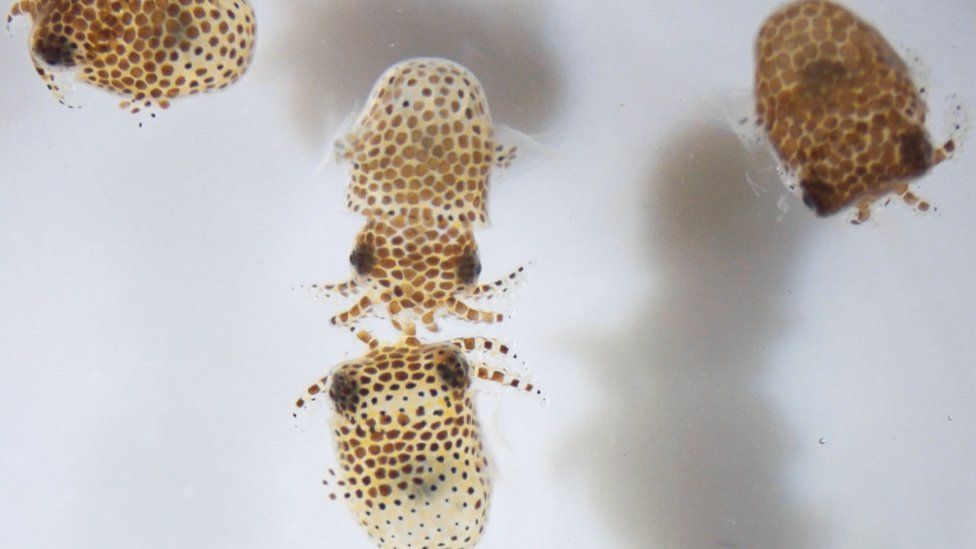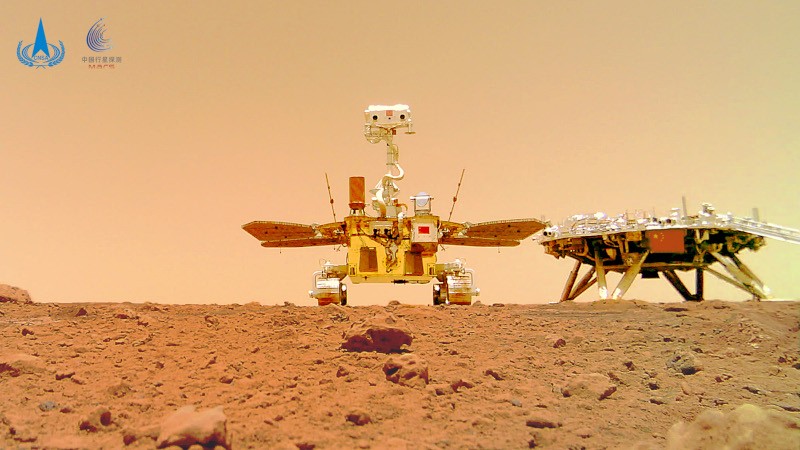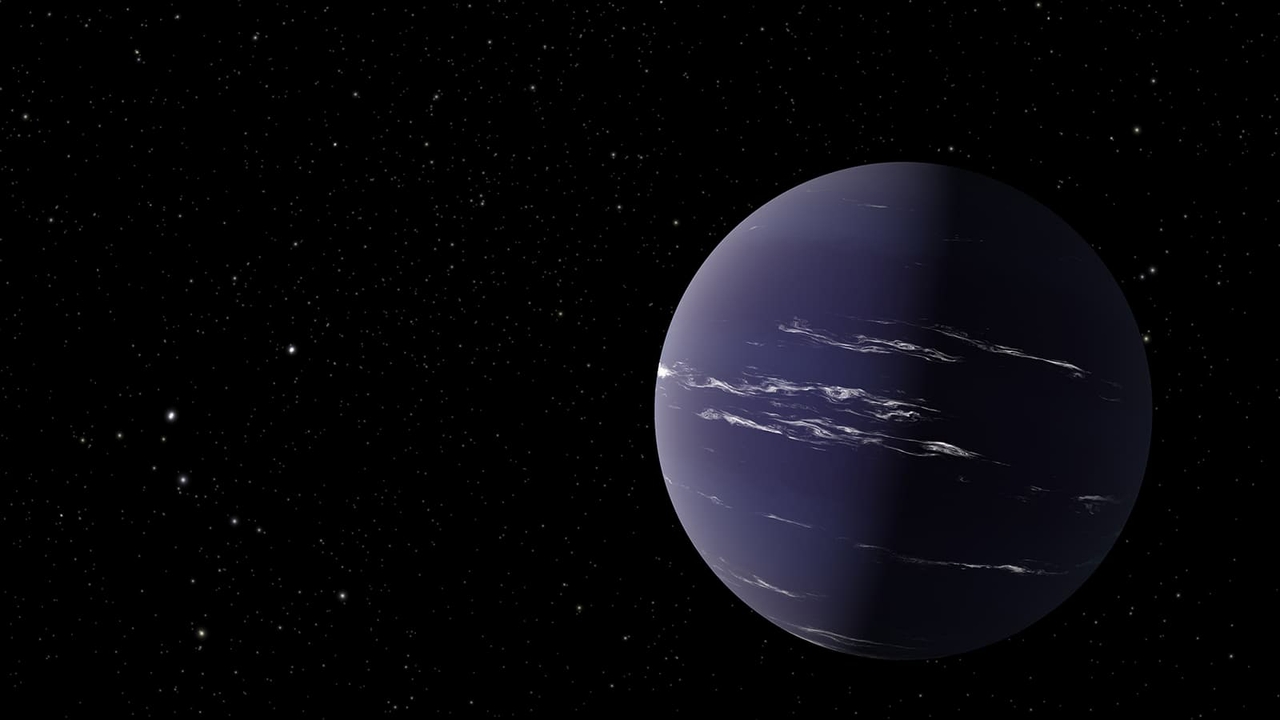Two seemingly unrelated stars, each with several exoplanets, turn out to be members of an enormous, diffuse star cluster. Plus, baby squid go to the ISS, new images from China’s Zhurong rover, a brightening blazar, and an interview with scientist Sophia Gad-Nasr and artist Cathrin Machin about how art and science work together.
Media
Transcript
Hello and welcome to the Daily Space. I am your host Dr. Pamela Gay, and I am here to put science in your brain.
Today we are happy to be bringing you two special guests: Sophia Gad-Nasr and Cathrin Machin. The two have recently teamed up to bring some amazing, science-based beauty into the world, and we’re going to talk about their collaboration and the problems it is creatively solving in the second half of our show.

It’s Friday, and at the end of a long week, sometimes it’s good to look back over the news cycle and find something adorbz to carry you into the weekend. There was one extremely cute story, in my opinion at least, that we didn’t have time to cover on Wednesday. That story? It was the launch of tiny, cute, baby squid to the ISS.
128 BABY BOBTAIL SQUID were launched on SpaceX’s most recent resupply mission. These tiny, sea creatures are just three millimeters long but have complex bodies that, like human bodies, interact with a microbiome of helpful bacteria. While we do our best to study how astronauts are affected by microgravity, we can’t launch 128 astronauts all at once to do a nice controlled experiment. This is where the squid come in. They were launched in a semi-frozen state to save them from a lot of the stress of takeoff and will now be thawed, allowed to do their happy baby squid thing, and ultimately returned to Earth.
Why Squid? It turns out that as different as humans and squid may seem, our immune systems are actually pretty similar to that of our cephalopod cousins. In an interview with the BBC, researcher Jaime Foster explained: As astronauts explore space, they’re taking with them a company of different microbial species. And it’s really important to understand how those microbes, collectively called the microbiome, change in the space environment and how those relationships are established.
As a reminder, the microbiome living on and in your body does everything from aid in digestion to eating up the moisture around your eyes while you sleep. While it’s gross to think about, it’s actually super cool and super necessary for our health.
So I agree we need a dose of cute to carry us into the weekend, but I’m gonna admit that not everyone is going to find squid – even baby squid – all that cute. So for those of you who need a different piece of adorable news, I present an adorable rover. You can get a high-resolution version of this image on our website.

Yesterday, China released the first photos taken by its Zhurong Mars Rover from the surface of Mars. This group photo was taken from a small camera dropped by the rover ten meters from the landing site – the robot equivalent of setting your phone down on a bench to take a picture with a friend. This image shows the rover and, in the background, the landing platform. The rover was delivered on top of the lander and rolled off of the ramp you can just make out on the edge of the image. The rover itself looks remarkably insect-like, with two camera eyes and large curved solar panels that remind me of butterfly wings. The gold of the rover’s body stands out to the red rocks of the Martian surface.
Not all science can be cute. Some of it is just cool. This week, we’ve brought up planets in other solar systems a whole bunch of times, and today we’re going to continue that theme.
One of the things that is frustrating is we can only study planetary atmospheres when something is lighting them up for us. Sunlight through a planetary atmosphere works really well but that means waiting for a planet to be aligned just right with its star, and it requires the star to not overwhelm the light coming through the planet’s atmosphere. Ideally, we want a planet with an orbit aligned to carry it in front of its star from our perspective, we want a star that is fairly faint, and we want everything to be moving fast enough that we don’t have to wait too long from one planet passing to the next. And we also want all of this to happen in a system that isn’t too far away.

That’s a lot to ask of any one system, but it turns out that one little star with a mighty large planet is out there happy to comply. Discovered by the TESS mission, the planet, TOI-1231 b, is a Neptune-sized world orbiting a small red dwarf every 25 days. And that system is just 90 light-years away.
Because this is a new discovery, we haven’t actually made those atmospheric measurements, yet. According to study collaborator Diana Dragomir: The low density of TOI 1231b indicates that it is surrounded by a substantial atmosphere rather than being a rocky planet. But the composition and extent of this atmosphere are unknown! TOI1231b could have a large hydrogen or hydrogen-helium atmosphere, or a denser water vapor atmosphere. Each of these would point to a different origin, allowing astronomers to understand whether and how planets form differently around M dwarfs when compared to the planets around our Sun, for example. Our upcoming HST observations will begin to answer these questions, and JWST promises an even more thorough look into the planet’s atmosphere.”
This work is published in The Astrophysical Journal with first author Jennifer Burt.
The universe is vast, and it’s always neat when it puts exactly what we need nearby.
Scientists don’t go looking for coincidences, and in general, when we find them, we don’t trust them to be more than accident and chance. But sometimes, the things we find are actually related.

Enter astronomers Jason Curtis and Marcel Agüeros. Working in a larger, multi-institutional team, these scientists were doing follow-up work on the planet-having systems Kepler 52 and Kepler 968. Both these systems have three planets orbiting a K-dwarf star – a star cooler and smaller than our Sun that is capable of living for billions of billions of years without showing its age.
This last characteristic is actually a bit problematic. When we look at systems with K-dwarf stars, we can’t easily measure their age – by which I mean we can’t measure their age. Instead, we guess based on where they are and what they seem to be related to. And sometimes we guess wrong.
Going into this study, it was thought K-52 and K-968 were several billion years old and utterly unrelated – simply strangers passing in the night through the original Kepler observing field. This starfield, however, is located in the region of the sky being studied by the Gaia space telescope, a telescope that can very precisely measure stellar distances, brightness, and motion.
We know that stars form in clusters as massive molecular clouds of gas and dust collapse and fragment. Over time, these clusters fall apart as stars at slightly different distances from the galactic center orbit at different rates. After enough orbits, the cluster stars that formed together are thoroughly mixed in with all the other stars of the galaxy.
But older clusters that may not be obvious to the eye can still be found using Gaia data because all the stars will be moving together through the galaxy like a load of people released from a shuttle bus to zip toward an airport entryway. Some will race ahead, others will lag behind, but the members can be spotted by their similar motions. If it’s a sports team or tour group, they may also all be wearing identical clothes that help them stand out as a single group. While stars don’t wear jerseys, all the stars that formed together will share the same chemical composition, and that is something we can see with spectrographs.
It turns out that these two stars are moving together, share the same spectra, and are part of a newly discovered star cluster that was named Theia 520. Other stars in this cluster, ones that it is easy to measure the age of, revealed that these stars are actually just 350 million years old. These are young planetary systems where the worlds are still settling into their orbits. And now we have two systems that are nearly identical that we get to study. Essentially, we can do a twins study just with stars.
So next time someone says, “That’s just a coincidence!”, remind them that sometimes there is something that is the cause behind it.
[Interview]
For now, though, this has been the Daily Space.
Learn More
Baby Squid Take to Space
Chinese Rover takes Selfie on Mars
Planetary Atmosphere Parades into Perfect View
- The University of New Mexico press release
- “TOI-1231 b: A Temperate, Neptune-Sized Planet Transiting the Nearby M3 Dwarf NLTT 24399,” Jennifer A. Burt et al., to be published in The Astronomical Journal (preprint on arxiv.org)
Stellar Siblings Found; Both Have Planets
- PDF: How Two Old and Unrelated Exoplanet Systems Turned Out to Be 350-million-year-old Siblings (AAS)
Credits
Written by Pamela Gay
Hosted by Pamela Gay
Audio and Video Editing by Ally Pelphrey
Content Editing by Beth Johnson
Intro and Outro music by Kevin MacLeod, https://incompetech.com/music/


 We record most shows live, on Twitch. Follow us today to get alerts when we go live.
We record most shows live, on Twitch. Follow us today to get alerts when we go live.